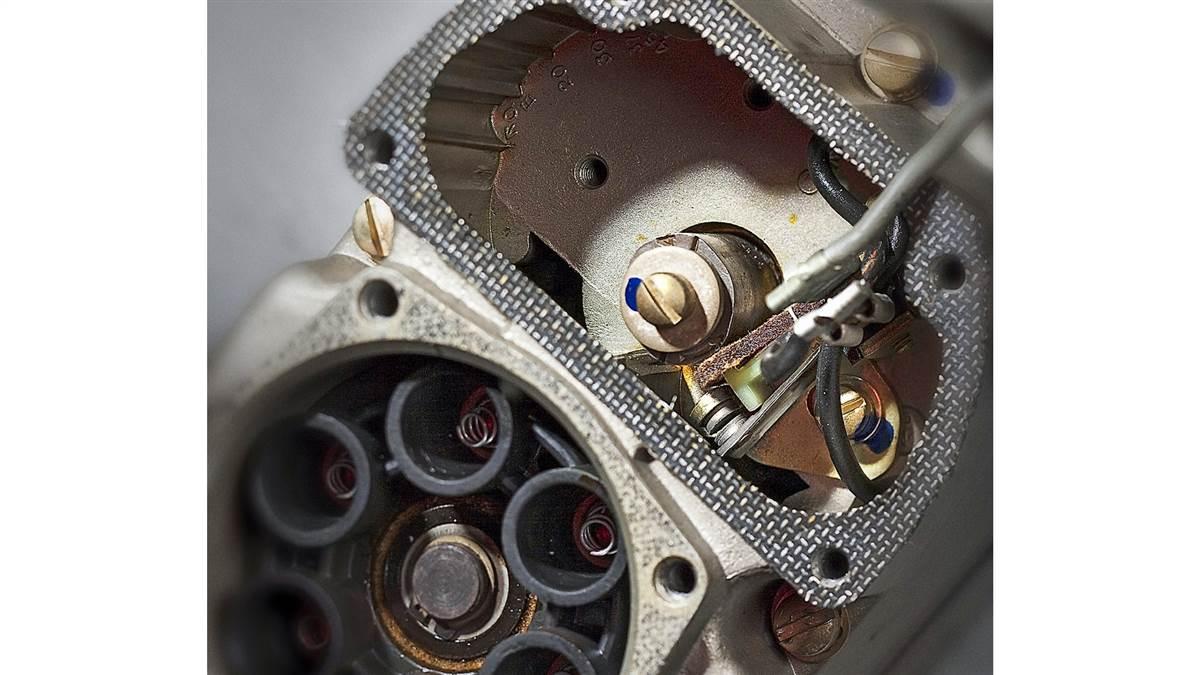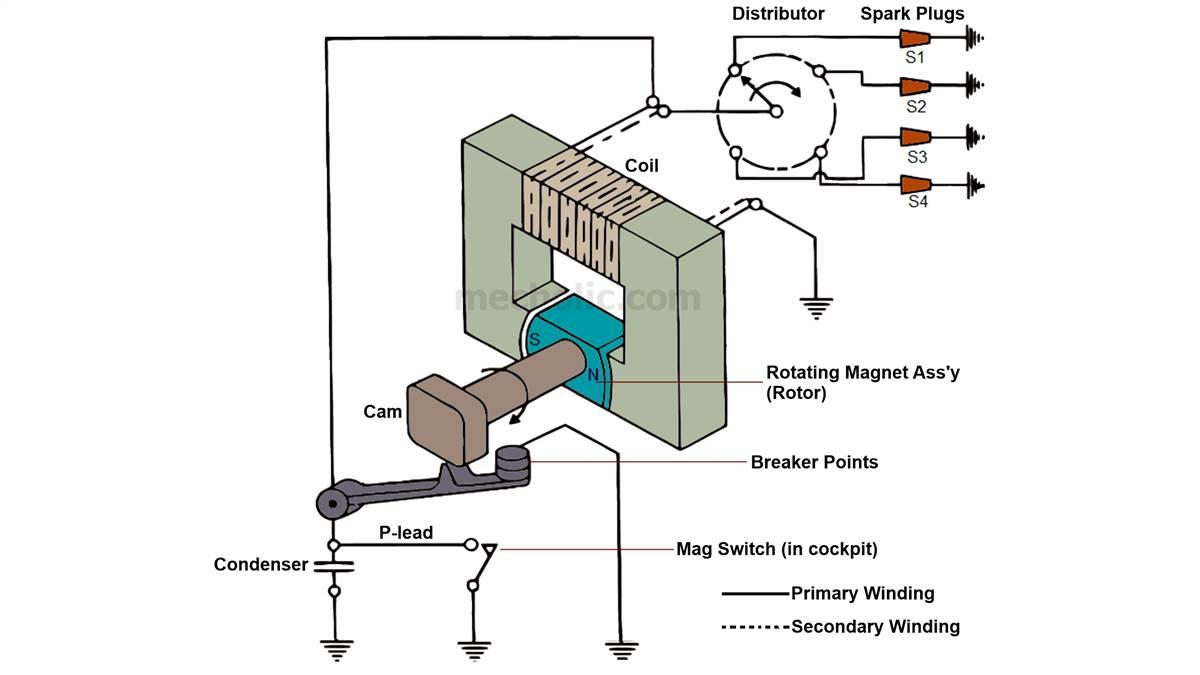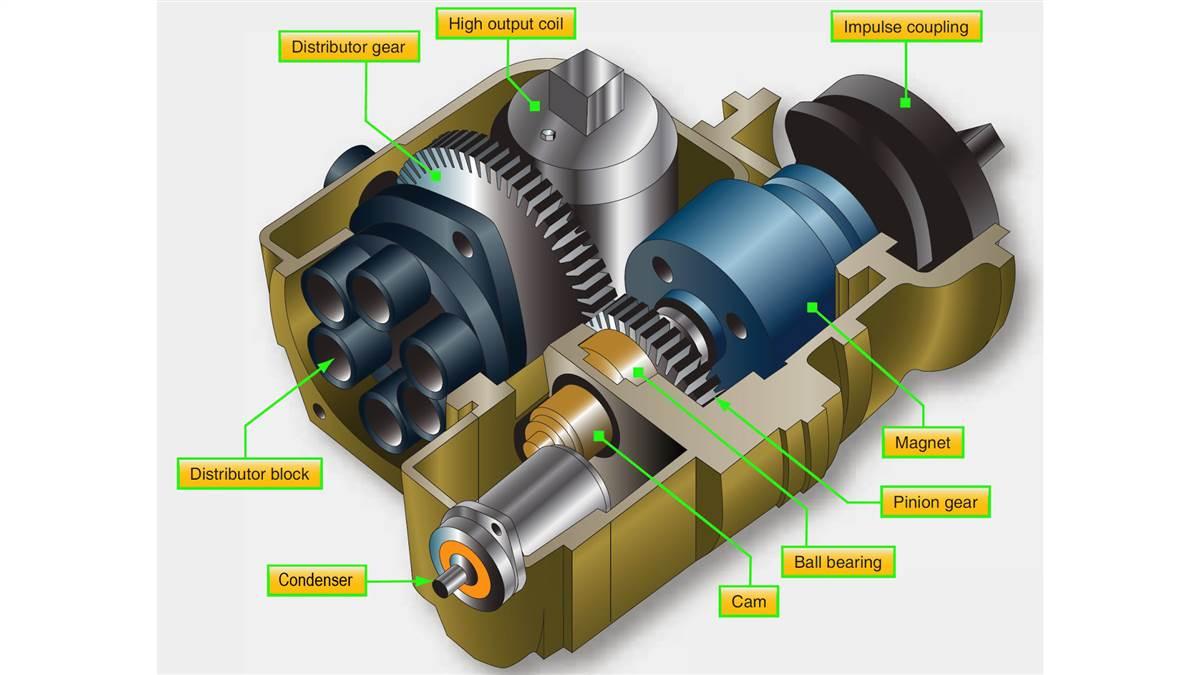Opinion: Savvy Maintenance
How mags work: The spark plugs in most piston aircraft engines are still powered by 120-year-old technology

The fact that we’re still stuck with these superannuated mechanical black boxes is a testament to just how hard it is to get modern technology certified by the FAA. Magneto ignition first appeared on the 1899 Daimler automobiles, and high-voltage magnetos were introduced by Bosch in 1903. Mags were largely abandoned in autos in the 1920s in favor of battery-powered ignition.
Electronic ignition systems (EIS) are almost universally used on experimental amateur-built aircraft but are still quite rare on certificated airplanes thanks to FAR Part 33 (“Airworthiness Standards: Aircraft Engines”), which remains firmly in the Dark Ages. The S-1200 magnetos on my airplane are essentially indistinguishable from the ones that Bendix built in the 1940s. Since so many of us are still flying behind these archaic “tractor mags,” it’s probably a good idea to understand how they work.
A high-voltage magneto is a self-contained ignition system that converts mechanical rotation into high-voltage pulses that are used to fire the spark plugs, without the need for external power from a battery or electrical system. They became the ignition system of choice for aircraft engines because they continue to function perfectly even in the face of a total electrical failure (which for some reason the FAA considers more likely than mechanical failure).

The rotor
The term “magneto” comes from the rotating permanent magnet assembly or rotor, which is spun by the engine’s accessory gearing. In a four-cylinder engine, the rotor turns at engine RPM; in a six-cylinder engine, it turns 1.5 times crankshaft speed. This magnetized rotor, together with the primary winding of the magneto’s coil, generates alternating current flow in the primary as the rotor turns. Each full rotation of the rotor induces two waves of alternating polarity electric current in the primary coil.
The amount of energy generated in the primary coil winding is a function of how strong the rotor’s magnet is and how fast it turns. Big mags (like the Bendix S-1200s in my airplane) generate more energy than do smaller ones (like the Slick 6300) because their rotors have bigger, more powerful magnets. Even more important is the rotor’s rotation speed. Like any alternator, mags generate their maximum energy when turning at full operating speed and put out a lot less energy at slow rpm (like when the engine is at idle).
The coil and breaker points
The primary winding of the coil typically consists of 180 turns of heavy-gauge copper wire wound around a laminated iron armature. One end of the coil is permanently grounded to the case of the magneto, while the other end is connected to a set of cam-operated tungsten breaker points. Normally, the points are closed, grounding both ends of the primary coil and allowing current induced by the rotor magnet to flow continuously around and around the coil. This current flow creates a powerful magnetic field in the coil’s iron core.
When the magneto’s cam opens the breaker points, it interrupts the flow of current in the primary coil winding and causes the magnetic field in the coil’s core to collapse suddenly. This induces a voltage spike in the primary that may be 200 or 300 volts when the engine is operating at takeoff or cruise rpm—enough to give you a jolt if you grabbed the magneto’s P-lead terminal while the engine was running, but it’s not even close to enough voltage to jump the gap of a spark plug. That’s where the coil’s secondary winding comes in.
The secondary winding consists of typically 18,000 turns of very fine magnet wire wound around the same core as the primary. One end of the secondary winding is grounded, while the other is hooked to the high-tension terminal of the coil. The two coil windings act as a step-up transformer. Since the secondary winding usually has 100 times as many turns as the primary, the 200- to 300-volt spike produced in the primary when the breaker points open induces a voltage of 20,000 to 30,000 in the secondary—enough to produce a nice hot spark.

The condenser
The breaker points are opened by mechanical action of the cam. During the first microseconds that the cam is opening the points, they’re still so close together that the 200- to 300-volt spike in the primary coil winding could arc across them. That would be a bad thing for two reasons. First, arcing causes a tiny amount of metal transfer from one breaker point to the other, and if left unchecked would cause the points to erode and pit. Second, arcing across the breaker points slows the collapse of the magnetic field in the coil, resulting in a lower voltage induced in the secondary and therefore a weaker spark at the plugs.
To prevent such arcing, a condenser (capacitor) is connected across the breaker points. Here’s how it works. At the moment of point opening, the initial voltage spike charges the condenser for 50 microseconds or so instead of arcing across barely separated breaker points. By the time the condenser is charged, the cam has separated the points far enough that the 200- or 300-volt spike in the primary coil cannot jump the gap. The result is a nice, predictable waveform and much longer-lasting points. If the condenser goes bad (as they sometimes do), mag performance degrades, and the points don’t last long.
The distributor
The high-voltage pulses produced by the secondary winding of the coil must be directed to the spark plug of each cylinder in sequence. The magneto accomplishes this by means of a mechanical distributor. The high-tension lead of the coil is connected to a rotating wiper on a large distributor gear that turns at one-half crankshaft speed inside the mag’s distributor block (cap), passing in close proximity to individual electrodes connected to the four or six or eight spark plug lead wires. The wiper doesn’t actually touch the electrodes, it just comes really close—which is why it is known as a “jump gap distributor.”
The high-voltage magneto became the ignition system of choice for aircraft engines because they continue to function perfectly even in the face of a total electrical failure.The distributor block is made of dielectric (nonconductive) material capable of withstanding tens of thousands of volts. It is essential that the inside of the distributor block remain clean and dry. The slightest bit of contamination—moisture, oil, or dirt—can impair the dielectric properties of the block and allow internal arc-over between distributor block terminals, causing engine misfire (particularly at high altitudes). Once such arc-over occurs, it tends to leave a carbonized track in its wake, facilitating subsequent arc-over events.
The P-lead
The P-lead is a wire that runs from the ungrounded end of the magneto coil’s primary winding to the cockpit mag switch (the P stands for primary). Its purpose is to allow the switch to disable the magneto by grounding the hot side of the primary. The P-lead is normally a 16-gauge shielded wire, with the shield grounded to the magneto case. Shielding of the P-lead is essential because an unshielded P-lead would act as an antenna and cause interference with avionics.
Because the P-lead is exposed to engine heat and vibration and air blast, broken P-leads are a common problem. A broken P-lead center conductor results in a dangerous “hot mag” condition in which the ignition switch is unable to shut off the magneto. A broken P-lead shield results in noisy radios and impaired nav performance.
Starting the engine
Once the engine is running, a magneto does a fine job of providing the required ignition. However, getting the engine started presents a couple of problems.
One problem is that starter motors generally crank the engine rather slowly—perhaps 50 rpm. The magneto is not capable of generating enough energy to fire a spark plug until it’s turning at least 150 rpm (referred to as the mag’s “coming in speed”). Even at that speed, the spark intensity is marginal at best. Another problem is that magneto-ignition aircraft engines have fixed ignition timing, typically 20 degrees to 28 degrees BTDC (before top dead center). But the engine won’t start with such ignition timing. If you cranked an engine at 50 rpm and a spark plug fired 20 degrees to 28 degrees before the piston reached the top of its compression stroke, the engine would kick back.
So, to get the engine to start, we need to do two things: coax the magneto into generating enough energy to fire the spark plugs at slow cranking speed, and retard the timing of the spark so the engine won’t kick back. Two different methods are commonly used to accomplish these things—one mechanical (impulse coupling), and the other electrical (retard breaker). Which you use depends on what kind of airplane you fly.
Impulse coupling
The impulse coupling is a mechanism that sits between the magneto’s drive shaft and the engine’s accessory drive. When the starter cranks the engine, a spring-loaded flyweight in the impulse coupling catches on a stationary stop pin mounted on the magneto case. This stops the magneto shaft from turning further.
As the engine continues to turn, an impulse spring in the hub is wound up for 25 degrees to 35 degrees of rotation (the lag angle) until a drive lug on the coupling body trips the flyweight, disengaging it from the stop pin. At this point, the wound-up impulse spring snaps the magneto through its firing position at an rpm much faster than cranking speed. Thus, the ignition timing is retarded (by lag angle of the coupling) and the magneto rotor is turned fast enough to generate a decent spark. Pretty clever.
Once the engine starts, centrifugal force causes the spring-loaded flyweights in the impulse coupling to retract so that they no longer catch on the stop pin. When this happens, the engine drives the magneto directly and timing returns to its normal setting of 20 degrees to 28 degrees BTDC.
Because impulse couplings have moving parts, they need to be inspected carefully during each 500-hour magneto inspection. An impulse coupling that comes apart in flight can cause a catastrophic engine failure. There are several ADs on impulse couplings—both Bendix and Slick—that have to be taken seriously.
Retard breaker
An alternative solution is the retard-breaker magneto pioneered by Bendix in its “Shower of Sparks” system. As the name implies, the retard-breaker mag makes use of a second set of breaker points to generate a spark at retarded ignition timing during engine start. Generally, only the left mag has the extra breaker points, and starting is done with the right mag disabled.
The extra set of points solves the problem of retarding the spark for starting, but the magneto is still turning too slowly to generate the energy required to fire a spark plug. So, aircraft battery power is converted into pulses by a starting vibrator—basically, a little electric buzzer—and those pulses are fed to the magneto coil’s primary winding via the P-lead, inducing high-voltage pulses in the secondary winding with sufficient energy to fire the spark plug.
The retard breaker system eliminates the mechanical risks associated with worn impulse couplings and produces easier starting because the spark plug fires a dozen times or so during each ignition event, rather than just once. It also saves a little weight. The one disadvantage is that it requires battery power to start, so you can’t hand-prop the engine with a dead battery.
SlickStart
In 1997, Unison (now Champion) introduced the SlickSTART magneto booster, essentially a solid-state replacement for the old starting vibrator used in the retard-breaker system. However, SlickSTART is approved for use with both Bendix and Slick mags, and both impulse coupling and retard breaker systems (excluding the Bendix D-2000/D-3000 dual mags). It produces a much hotter spark for starting than either a starting vibrator or impulse coupling and is far better at firing oil- or carbon-fouled plugs. If your engine is hard to start or you operate in frigid temperatures, it’s a worthwhile upgrade.

